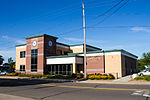Hassan Township, Hennepin County, Minnesota

Hassan Township was an urban township in Hennepin County, Minnesota, United States. Located in the northwestern corner of the county, it was the last remaining township in the county. The population was 2,600 at the 2010 census.The town began incorporation proceedings in 2003 but abandoned its petition and chose to sign a Joint Powers agreement with the nearby city of Rogers to annex the entirety of Hassan Township. The Hassan Town Board approved annexation in June 2008 with orderly annexation to begin in 2012.The origin of the name comes from the Dakota word chanhasen meaning the "sugar-maple tree" (chan, tree; haza, a tree with sap). Since the then-township of Chanhassen had established two years before Hassan, the chan syllable was dropped to avoid confusion.
Excerpt from the Wikipedia article Hassan Township, Hennepin County, Minnesota (License: CC BY-SA 3.0, Authors, Images).Hassan Township, Hennepin County, Minnesota
135th Avenue North,
Geographical coordinates (GPS) Address Nearby Places Show on map
Geographical coordinates (GPS)
| Latitude | Longitude |
|---|---|
| N 45.2 ° | E -93.583333333333 ° |
Address
135th Avenue North 23900
55374
Minnesota, United States
Open on Google Maps








